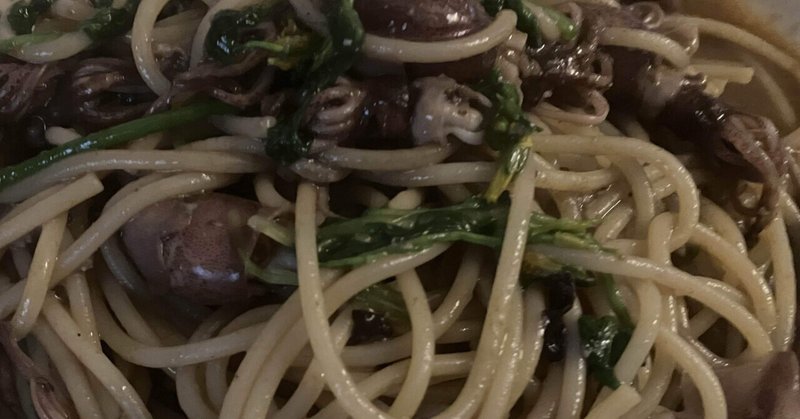
蛍烏賊とハコベのスパゲティーニ Firefly squid and chickweed spaghetti
ストーリー Recipe trivia
仕事で使う場合は別だけど、実は個人的には緑の葉を買う頻度はそれほど多くない。この時期だと冬菜漬にするのに旬の冬菜を纏めて買うくらい。サラダ用や普段の青菜は大体アパートの中庭のプランターか近所の空き地で手に入るからだ。その中でも早春から初夏にかけていくらでも手に入るのがこの「ハコベ」。ほとんどの人には雑草にしか見えないだろうが、癖がなく柔らかくて生食でき、なかなか重宝する野草だ。実は万葉の時代から食べられていた。春の七草に出てくる「ハコベラ」はハコベのことだ。大規模な野菜の栽培が行われるずっと前から日本列島や朝鮮半島では摘み菜として採集されていた。「春の七草」詩はその名前を唄っている。この七草がどんなに日本で身近かというと、鎌倉の僕の住居から3分圏内に、すっかり栽培野菜になってしまった大根と蕪は別として、全て見つけることができる。生命力の強い雑草達だ。欧米では「鶏の草」とか「鳥のサラダ」とかの名前で呼ばれる。漢方薬としても古くから知られている。
Except when I need it for work, I don't buy green leaves that often. At this time of year, I buy a bunch of seasonal winter vegetables to make winter pickles. I can usually get salads and other greens from the planters in the courtyard of my apartment or from vacant lots in the neighborhood. Among them, Hakobe(chickweed) is available in abundance from early spring to early summer. To most people, it's just a weed that they step on and don't notice, but it's a very useful wild plant because it has no peculiar taste, is soft, and can be eaten raw. In fact, it has been eaten since the Manyo period. “Hakobera”, known as one of the seven spring herbs in Japan, is chickweed. It was collected as picking herbs in the Japanese archipelago and the Korean peninsula long before large-scale vegetable cultivation began. The poem "Seven Herbs of Spring" sings the names of these wild herbs. To give you an idea of how familiar these seven herbs are in Japan, I can find them all within a three-minute radius of where I live in Kamakura. They are weeds with strong vitality. In the West, they are called "chicken grass" or "bird salad." They have long been known as Chinese medicine.

これは、そのハコベと今が旬の蛍烏賊でスパゲティーニに仕立てた一品。
ホタルイカは産卵期を控えて丸々太り、今が旬。日本の市場に出回っている。富山産が有名で毎年3月1日に禁漁が解かれて流通する。もっと早い時期から流通しているものは兵庫産か山陰産が多い。富山産は定置網漁で丁寧に獲られるので数も少なく値段も高い。大ぶりで刺身向きだ。他の産地のものは底引網漁で大量に水揚げされ主に茹でて出荷されるるので、小ぶりだけど値段が安く流通時期も長い。ここではたっぷり使いたいのでそちらの方を使っている。
This is a dish of spaghettini made with chickweed and firefly squid, which is in season now.
Firefly squid are plump ahead of the spawning season and are in season now. They are available in Japanese markets. Those from Toyama are famous, and they are released into the market every year on March 1st when the fishing ban is lifted. This type of squid, which is available from an earlier time, is mostly from Hyogo or Sanin. Toyama squid are carefully caught using fixed net fishing, so there are few in number and they are expensive. They are large and perfect for sashimi. Those from other areas are caught in large quantities using bottom trawl fishing and are mainly boiled before shipping, so although they are small, they are cheap and have a longer distribution period. I use that version because I want to use a generous amount in this recipe.

Ingredients:
材料:
スパゲティーニ
茹で蛍烏賊
中庭に生えてたハコベ
オリーブ油とひまわり油
柚子胡椒※
にんにく
自然塩
黒胡椒
※唐辛子でも良い
Spaghettini
Firefly squid
Chickweed growing in the courtyard
Olive oil and sunflower oil
Yuzu pepper*
Garlic
Salt
Black pepper
*Chili peppers are fine too
procedure:
手順:
蛍烏賊は、トゲ抜きなどを使って、目玉と軟骨を取り除いておく。面倒だけど、食感が全く違う。ハコベは固い茎や枯れた部分を取り除きよく洗って水を切っておく。
スパゲティーニを表記時間より少し短めに茹でる。火口が一つの場合はさらに硬めに仕上げて油をまぶしておく。茹で汁は取っておく。
鍋に油と潰したにんにくを入れ(柚子胡椒の代わりに唐辛子のホールを使う場合はこのタイミングで入れる)、にんにくの香りが立ってきたら、茹でたスパゲティーニ、蛍烏賊と茹で汁少量、自然塩を入れ、かき混ぜながらしばらく炒める。蛍烏賊の内蔵が破れて黒っぽく色づいてきたら、柚子胡椒とハコベを入れて仕上げる。パスタがとろっとした乳化(油と煮汁と溶けた蛍烏賊の内蔵が一体となる状態)したソースをまとった状態になるよう、油と茹で汁を加減しながら加え、最後に塩味を調整して仕上げる。
Remove the eyes and cartilage from the firefly squid using a spine remover. It's a little tedious, but it makes a huge difference in texture. Remove the tough stems and dead parts of the chickweed, wash it well, and drain the water.
Boil the spaghettini for a little less time than the stated time. If you have only one burner, boil the spaghettini until it is firmer and coat with oil. Reserve the cooking water.
Put the oil and crushed garlic in a pot(If you are using whole chili peppers instead of yuzu pepper, add them at this point.), and when the garlic starts to smell, add the boiled spaghettini, firefly squid, a little cooking water, and salt, and stir-fry for a while. When the firefly squid's innards have burst and turned dark, add the yuzu pepper and chickweed to finish. Add more oil and cooking water, adjusting the amount so that the pasta is covered in a thick, emulsified sauce (the oil, cooking water, and dissolved firefly squid innards are integrated), and finish by adjusting the saltiness.







Tips and tricks:
コツと応用のヒント:
僕はパスタを茹でる時塩を使わない。塩を入れる明快な理由がないように感じるのと仕上げが意図より塩辛くなるリスクを回避するためだけど、これは僕のスタイルなので、考えの違う人は真似しなくても良い。
僕は、さっぱりしたパスタには重い油を使いたくないので、ひまわり油にエキストラバージンを足して使っているけど、お好みで、酸化しにくい油なら何を使っても良い。
ここでは、日本的な風味を出すため柚子胡椒(柚子の皮と青唐辛子をペーストにした日本の調味料)を使ったが、普通の唐辛子を使っても良いし、好みの唐辛子ベースの調味料があるなら、それを使っても良い。
写真には黄色い花が入っているが、これは野生の菜花の花。彩にハコベと一緒に採集したもの。ハコベに加えて爽やかで彩りの良い春の野草なら何を使っても良い。
解けたにんにくと烏賊の内蔵、茹で汁の成分が繋ぎになって、油と水分をソースのように乳化させることができると、パスタに烏賊の旨みを上手に絡めることができる。にんにくを炒める時の油を控えめにし、パスタが茹で汁を吸って煮詰まり始めた最後に油を加減しながら足していくと、この状態に持っていくことができる。
水を入れすぎたり、どうしてもソース状にならない場合は無理せず、ちょっと小麦粉か片栗粉を振ろう。不本意かもしれないけど、ふやけたパスタを食べるより遥かに良い機転だと思う。
I don't use salt when boiling pasta. I don't think there's a clear reason to add salt, and I do it to avoid the risk of the finished product being saltier than intended, but this is my style, so people who think differently don't have to imitate me.
I don't want to use heavy oils for light pasta, so I use sunflower oil with extra virgin olive oil added, but you can use any oil you like as long as it doesn't oxidize easily.
Here, I used yuzu kosho (a Japanese seasoning made from a paste of yuzu peel and green chili peppers) to give it a Japanese flavor, but you can use regular chili peppers, or if you have a favorite chili-based seasoning, you can use that too.
The photo shows yellow flowers, which are wild rape blossoms. I collected them together with chickweed for color. In addition to chickweed, it's good to add refreshing and colorful spring wild plants to the ingredients.
If the dissolved garlic, squid innards, and ingredients from the boiling water act as a binder and can emulsify the oil and water like a sauce, the flavor of the squid can be nicely incorporated into the pasta. You can achieve this by using a moderate amount of oil when frying the garlic, and then adding more oil at the end once the pasta has absorbed the cooking water and begun to thicken.
If you add too much water or it just won't become sauce-like, don't force it. Sprinkle a little flour or cornstarch on top. It may be unpleasant, but it's a much better idea than eating soggy pasta.
Guide to where to find ingredients 材料入手先ガイド
この記事が気に入ったらサポートをしてみませんか?
